Mark the odd one w.r.t . T.S. of a plant's part
1 Vascular bundles are arranged in ring
2 Epidermis is covered by a thin layer of cuticle
3 The cells of the endodermis have a deposition of water - impermeable, waxy material called lignin
4 Pericycle contains both sclerenchyma and parenchyma
Vascular bundles are arranged in ring
Epidermis is covered by a tin layer of cuticle
The cells of the endodermis have a deposition of water - impermeable, waxy material called lignin
Pericycle contains both sclerenchyma and parenchyma
The correct Answer is:3
To solve the question of marking the odd one with respect to the transverse section (T.S.) of a plant's part, we will analyze each option step by step:
1. Option 1: Vascular bundles are arranged in a ring.
- In a dicot stem, vascular bundles (which consist of xylem and phloem) are typically arranged in a ring. This is a characteristic feature of dicotyledonous plants.
- Conclusion: This statement is correct and not the odd one.
2. Option 2: Epidermis is covered by a thin layer of cuticle.
- The epidermis serves as the outer protective layer of the plant and is often covered by a thin layer of cuticle, which helps in reducing water loss.
- Conclusion: This statement is also correct and not the odd one.
3. Option 3: The cells of the endodermis have a deposition of water-impermeable, waxy material called lignin.
- The endodermis is the innermost layer of the cortex in roots. It is characterized by a deposition of a water-impermeable substance, but this substance is called suberin, not lignin. Lignin is found in other parts of the plant, such as in the xylem.
- Conclusion: This statement is incorrect and is the odd one out.
4. Option 4: Pericycle contains both sclerenchyma and parenchyma.
- The pericycle is a layer of cells located just inside the endodermis and can contain both sclerenchyma (which provides strength) and parenchyma (which is involved in storage and transport).
- Conclusion: This statement is correct and not the odd one.
Final Answer:
The odd one out is Option 3: The cells of the endodermis have a deposition of water-impermeable, waxy material called lignin.
---
- In a dicot stem, vascular bundles (which consist of xylem and phloem) are typically arranged in a ring. This is a characteristic feature of dicotyledonous plants.
- Conclusion: This statement is correct and not the odd one.
- The epidermis serves as the outer protective layer of the plant and is often covered by a thin layer of cuticle, which helps in reducing water loss.
- Conclusion: This statement is also correct and not the odd one.
- The endodermis is the innermost layer of the cortex in roots. It is characterized by a deposition of a water-impermeable substance, but this substance is called suberin, not lignin. Lignin is found in other parts of the plant, such as in the xylem.
- Conclusion: This statement is incorrect and is the odd one out.
- The pericycle is a layer of cells located just inside the endodermis and can contain both sclerenchyma (which provides strength) and parenchyma (which is involved in storage and transport).
- Conclusion: This statement is correct and not the odd one.
The odd one out is Option 3: The cells of the endodermis have a deposition of water-impermeable, waxy material called lignin.
Topper's Solved these Questions
- ANATOMY OF FLOWERING PLANTS BOOK - VMC MODULES ENGLISHCHAPTER - ANATOMY OF FLOWERING PLANTS EXERCISE - IMPECCABLE
59 Videos
- ANATOMY OF FLOWERING PLANTS BOOK - VMC MODULES ENGLISHCHAPTER - ANATOMY OF FLOWERING PLANTS EXERCISE - ENABLE
50 Videos
- BIODIVERSITY AND CONSERVATIONBOOK - VMC MODULES ENGLISHCHAPTER - BIODIVERSITY AND CONSERVATIONEXERCISE - IN-CHAPTER EXERCISE-B
10 Videos
Similar Questions
Read the following statements with respect to dicot stem and select the right choice .
i. The epidermis is covered with a thick layer of cuticle .
ii. The cells of endodermis are rich in starch grains.
iii. The pericycle is present on the inner side of endodermis and above the phloem in the of semilunar patches of sclerenchyma.
iv. The vascular bundles are arranged in a ring .
View SolutionA screen is at distance D=80 cm form a diaphragm having two narrow slits S1 and S2 which are d=2 mm apart.
Slit S1 is covered by a transparent sheet of thickness
t1=2.5μm slit S2 is covered by another sheet of thickness
t2=1.25μm as shown if Fig. 2.52.
Both sheets are made of same material having refractive index μ=1.40
Water is filled in the space between diaphragm and screen. A monochromatic light beam of wavelength λ=5000Å is incident normally on the diaphragm.
Assuming intensity of beam to be uniform, calculate ratio of intensity of C to maximum intensity of interference pattern obtained on the screen (μw=4/3)
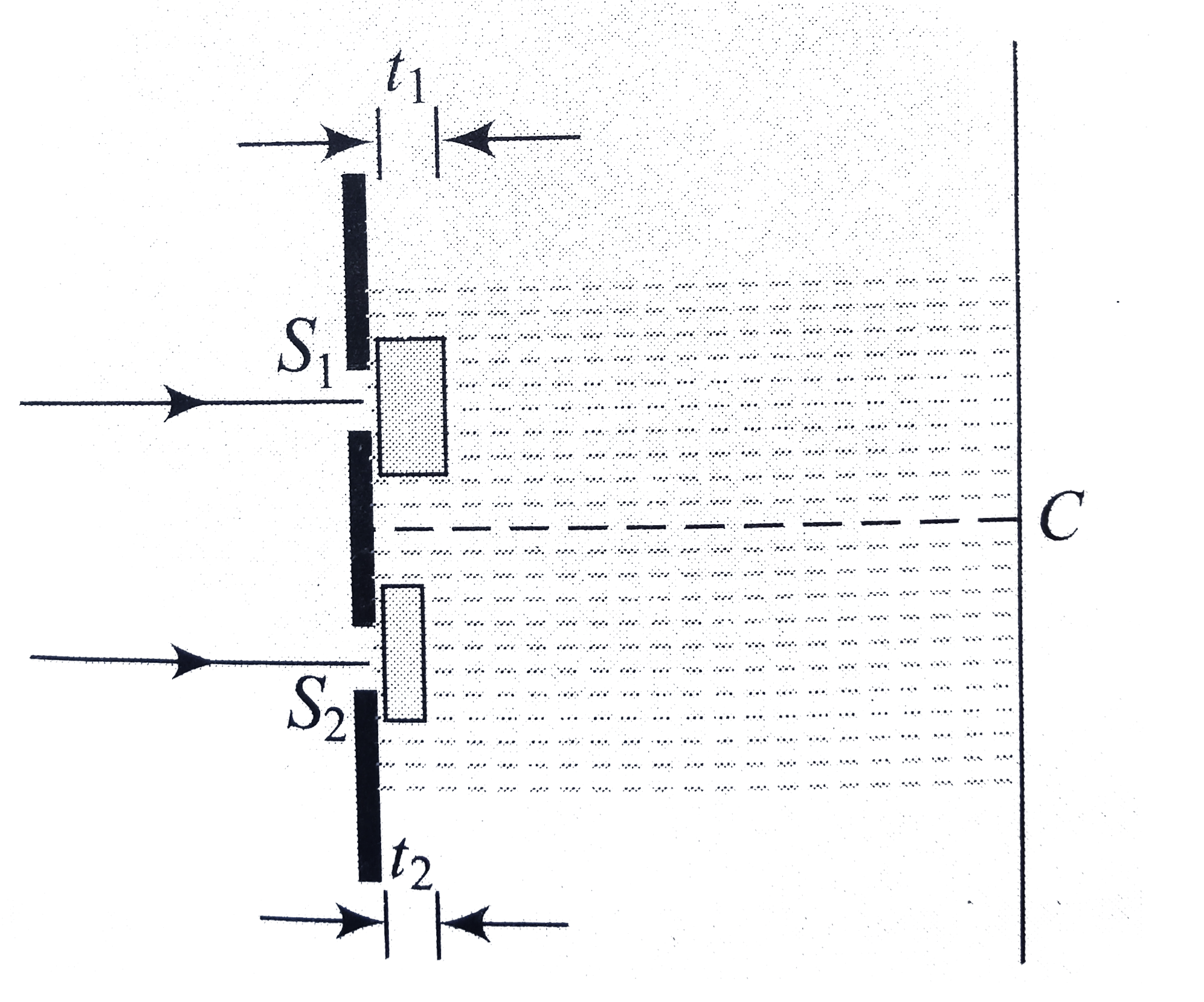
View Solution
Knowledge Check
How a Cat in a Hat Changed Children’s Education
In a 1954 Life magazine article, author John Hersey expressed concern that children in the United States were disengaged from learning how to read. Among other problems, Hersey noted, the reading material available to grade-schoolers had a hard time competing with television, radio, 1 and–––– other media for children’s attention. One solution he proposed was to make children’s books more 2 interesting, since “an individual’s sense of wholeness . . . follows, and cannot precede, a sense of accomplishment.”––––––––––––––––––––––––––––––––––––––––––––––––––––––––––––––––––––––––––––––––––––––––––––––––––––––––––––––––––––––––––
The story of The Cat in the Hat’s publication began when William 3 Spaulding, the director––––––––––––––––––––––––– of the education division at the publishing company Houghton Mifflin, read Hersey’s article and had an idea. Spaulding agreed that there was a need for appealing books for beginning 4 readers. He–––––––––––– thought he knew who should write one. He arranged to have dinner with Theodor Geisel, who wrote and illustrated children’s books under the name “Dr. Seuss,” and issued him a challenge: “Write me a story that first graders can’t put down .
Having 5 known Spaulding for many years and having maintained a professional relationship with him––––––––––––––––––––––––––––––––––––––––––––––––––––––––––––––––––––––––––––––––––––––––––––––––––––, Geisel was an experienced writer and illustrator. 6 However––––––––––, this new project presented him with an obstacle. Spaulding told Geisel to write his entire book using a restricted vocabulary from an elementary school list of 348 words. Geisel started two stories, only to abandon them when he found that he needed to use words that were not on the list. On the verge of giving up, 7 Geisel’s story finally hit upon an image that became its basis–––––––––––––––––––––––––––––––––––––––––––––––––––––––––––––––––: a cat wearing a battered stovepipe hat. His main character established, Geisel commenced the difficult task of writing a book with a limited vocabulary. 8 At the end of a duration nine months long–––––––––––––––––––––––––––––––––––––––––––––, The Cat in the Hat was complete.
The book was a hit. Children were entertained by its plot about the antics of a mischievous cat and 9 is–– captivated by its eye-catching illustrations and memorable rhythms and rhymes. Its sales inspired another publishing company, Random House, to establish a series for early readers called Beginner Books, which featured works by Geisel and other writers, and other publishers quickly followed suit. In the years that 10 followed. Many––––––––––––––––– talented writers and illustrators of children’s books imitated Geisel’s formula of restricted vocabulary and whimsical artwork. But perhaps the best proof of The Cat in the Hat’s success is not its influence on other books but its 11 limited vocabulary and appealing word choices–––––––––––––––––––––––––––––––––––––––––––––––––––.
The writer wants to include a quotation by Hersey that supports the topic of the passage. Which choice best accomplishes this goal?ANO CHANGEBinteresting, since “learning starts with failure, the first failure is the beginning of education.”Cinteresting because “journalism allows its readers to witness history, fiction gives its readers an opportunity to live it.”Dinteresting with “drawings like those of the wonderfully imaginative geniuses among children’s illustrators.”How a Cat in a Hat Changed Children’s Education
In a 1954 Life magazine article, author John Hersey expressed concern that children in the United States were disengaged from learning how to read. Among other problems, Hersey noted, the reading material available to grade-schoolers had a hard time competing with television, radio, 1 and–––– other media for children’s attention. One solution he proposed was to make children’s books more 2 interesting, since “an individual’s sense of wholeness . . . follows, and cannot precede, a sense of accomplishment.”––––––––––––––––––––––––––––––––––––––––––––––––––––––––––––––––––––––––––––––––––––––––––––––––––––––––––––––––––––––––––
The story of The Cat in the Hat’s publication began when William 3 Spaulding, the director––––––––––––––––––––––––– of the education division at the publishing company Houghton Mifflin, read Hersey’s article and had an idea. Spaulding agreed that there was a need for appealing books for beginning 4 readers. He–––––––––––– thought he knew who should write one. He arranged to have dinner with Theodor Geisel, who wrote and illustrated children’s books under the name “Dr. Seuss,” and issued him a challenge: “Write me a story that first graders can’t put down .
Having 5 known Spaulding for many years and having maintained a professional relationship with him––––––––––––––––––––––––––––––––––––––––––––––––––––––––––––––––––––––––––––––––––––––––––––––––––––, Geisel was an experienced writer and illustrator. 6 However––––––––––, this new project presented him with an obstacle. Spaulding told Geisel to write his entire book using a restricted vocabulary from an elementary school list of 348 words. Geisel started two stories, only to abandon them when he found that he needed to use words that were not on the list. On the verge of giving up, 7 Geisel’s story finally hit upon an image that became its basis–––––––––––––––––––––––––––––––––––––––––––––––––––––––––––––––––: a cat wearing a battered stovepipe hat. His main character established, Geisel commenced the difficult task of writing a book with a limited vocabulary. 8 At the end of a duration nine months long–––––––––––––––––––––––––––––––––––––––––––––, The Cat in the Hat was complete.
The book was a hit. Children were entertained by its plot about the antics of a mischievous cat and 9 is–– captivated by its eye-catching illustrations and memorable rhythms and rhymes. Its sales inspired another publishing company, Random House, to establish a series for early readers called Beginner Books, which featured works by Geisel and other writers, and other publishers quickly followed suit. In the years that 10 followed. Many––––––––––––––––– talented writers and illustrators of children’s books imitated Geisel’s formula of restricted vocabulary and whimsical artwork. But perhaps the best proof of The Cat in the Hat’s success is not its influence on other books but its 11 limited vocabulary and appealing word choices–––––––––––––––––––––––––––––––––––––––––––––––––––.ANO CHANGEBand withCand alsoDand competing with
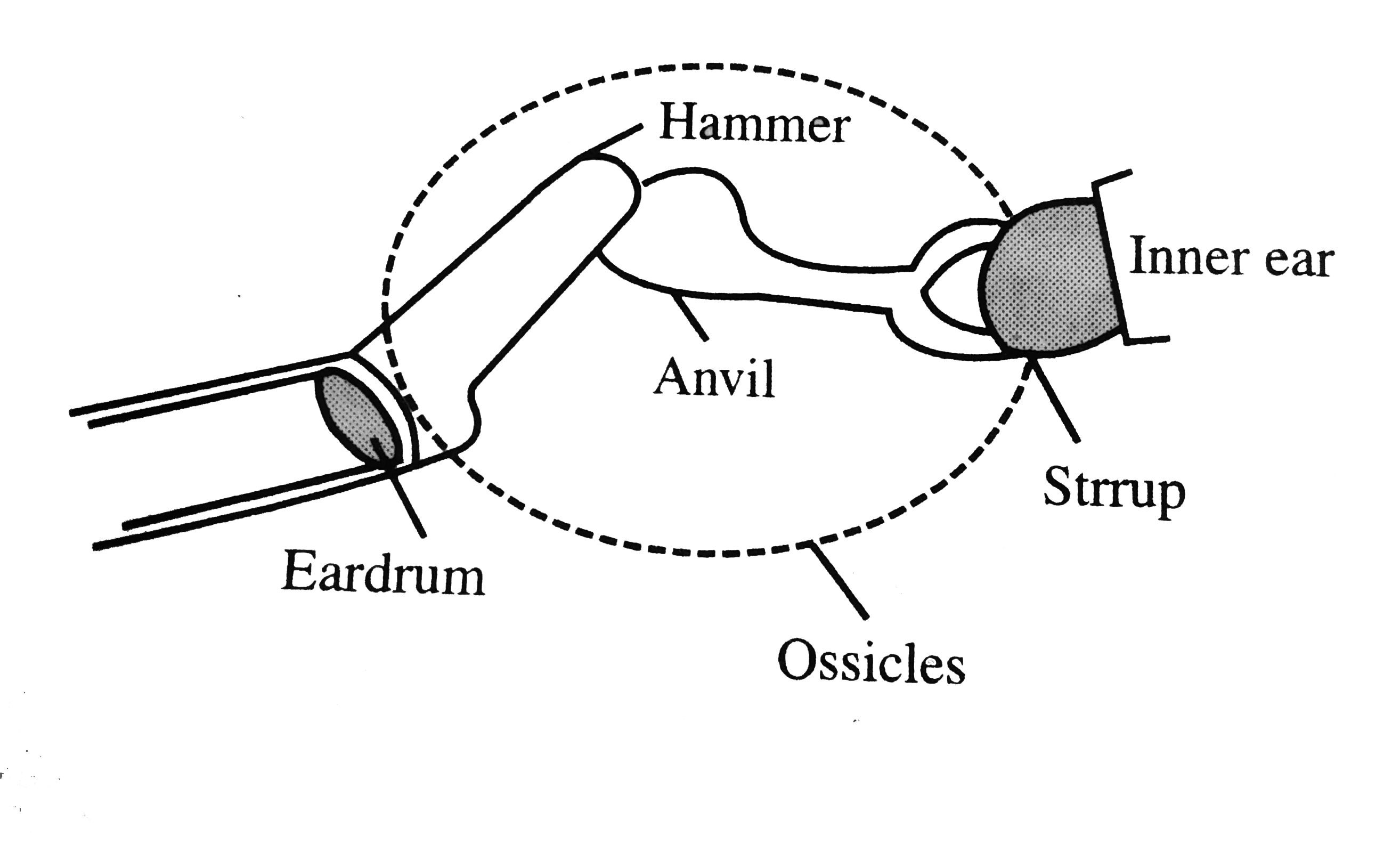
When a sound wave enters the ear, it sets the eardrum into oscillation, which in turn causes oscillation of 3 tiny bones in the middle ear called ossicles. This oscillation is finally transmitted to the fluid filled in inner portion of the ear termed as inner ear, the motion of the fluid disturbs hair cells within the inner ear which transmit nerve impulses to the brain with the information that a sound is present. The theree bones present in the middle ear are named as hammer, anvil and stirrup. Out of these the stirrup is the smallest one and this only connects the middle ear to inner ear as shown in the figure below. The area of stirrup and its extent of connection with the inner ear limits the sensitivity of the human ear consider a person's ear whose moving part of the eardrum has an area of about 50mm2 and the area of stirrup is about 5mm2. The mass of ossicles is negligible. As a result, force exerted by sound wave in air on eardum and ossicles is same as the force exerted by ossicles on the inner ear. Consider a sound wave having maximum pressure fluctuation of 4×10−2Pa from its normal equilibrium pressure value which is equal to 105Pa. Frequency of sound wave in air is 332ms. Velocity of sound wave in fluid (present in inner ear) is 1500ms. Bulk modulus of air is 1.42×105Pa. Bulk modulus of fluid is 2.18×109Pa.
Q. This person (without hearing aid machine) is sitting inside a busy restaurant where average sound intensity is 3.2×10−5Wm2. How much energy in the form of sound is taken up by the person in his meal time of 1 h?
View Solution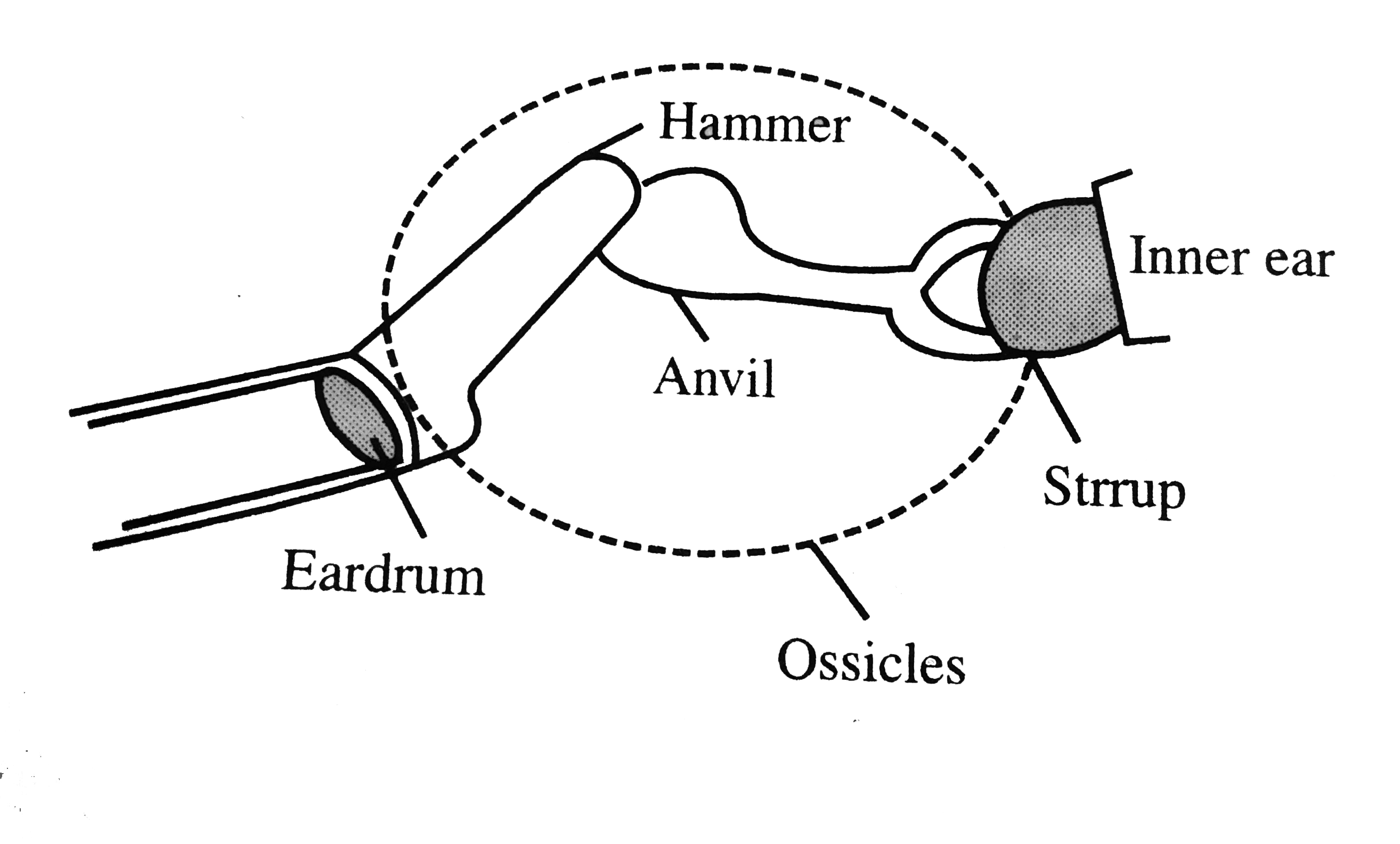
When a sound wave enters the ear, it sets the eardrum into oscillation, which in turn causes oscillation of 3 tiny bones in the middle ear called ossicles. This oscillation is finally transmitted to the fluid filled in inner portion of the ear termed as inner ear, the motion of the fluid disturbs hair cells within the inner ear which transmit nerve impulses to the brain with the information that a sound is present. The theree bones present in the middle ear are named as hammer, anvil and stirrup. Out of these the stirrup is the smallest one and this only connects the middle ear to inner ear as shown in the figure below. The area of stirrup and its extent of connection with the inner ear limits the sensitivity of the human ear consider a person's ear whose moving part of the eardrum has an area of about 50mm2 and the area of stirrup is about 5mm2. The mass of ossicles is negligible. As a result, force exerted by sound wave in air on eardum and ossicles is same as the force exerted by ossicles on the inner ear. Consider a sound wave having maximum pressure fluctuation of 4×10−2Pa from its normal equilibrium pressure value which is equal to 105Pa. Frequency of sound wave in air is 332ms. Velocity of sound wave in fluid (present in inner ear) is 1500ms. Bulk modulus of air is 1.42×105Pa. Bulk modulus of fluid is 2.18×109Pa.
Q. With respect to information provided above, mark the correct statement.
View SolutionIn a Young's double slit experiment, a parallel beam containing wavelengths λ1=4000Å and λ2=5600Å is incident at an angle ϕ=30∘ on a diaphragm having narrow slits at separation d=2mm. The screen is placed at a distance D =40 cm from the slits. a mica slab of thickness t=5mm is placed in front of one of the slits and whole of the apparatus is submerged in water. if the central bright fringe is observed at C, determine.

(i) The refractive index of the slab
(ii) The distance of first black line from C
both wavelength are in air. take μw=43
View SolutionIn YDSE's experiment performed in a medium of refractive index (4/3), a light of 60 nm wavelength is falling ono the slits having 0.45 mm separation.t he lower slit S2 is covered by a thin glass sheet of thickness 10.4μm and refractive index 1.5 the interference pattern is observed on a screen palced 1.5m from the slits as shown int hef ignore dispersion.
Q. If white light of range 400-700 nm has replaced 600 nm light, one of the wavelengths of light that forms maxima exactly at point O wll be:

View SolutionIn the circuit shown in Fig. the capacitor has capacitance C=20μF and is initially charged to 100V with the polarity shown. The resistor R0 has resistance 10Ω. At time t=0, the switch is closed. The smaller circuit is not connected in any way to teh larger one. the wire of the smaller circuit has a resistance of 1.0Ωm−1 and contains 25 loops. the larger circuit is a rectangle 2.0m by 4.0m, while the smaller one has dimensions a=10.0cm and b=20.0cm. the distance cis 5.0cm. (The figure is not drawn to scale.) Both circuit are held stationary. Assume that only the wire nearest to teh smaller circuit produces. an appreciable magnetic field through it.
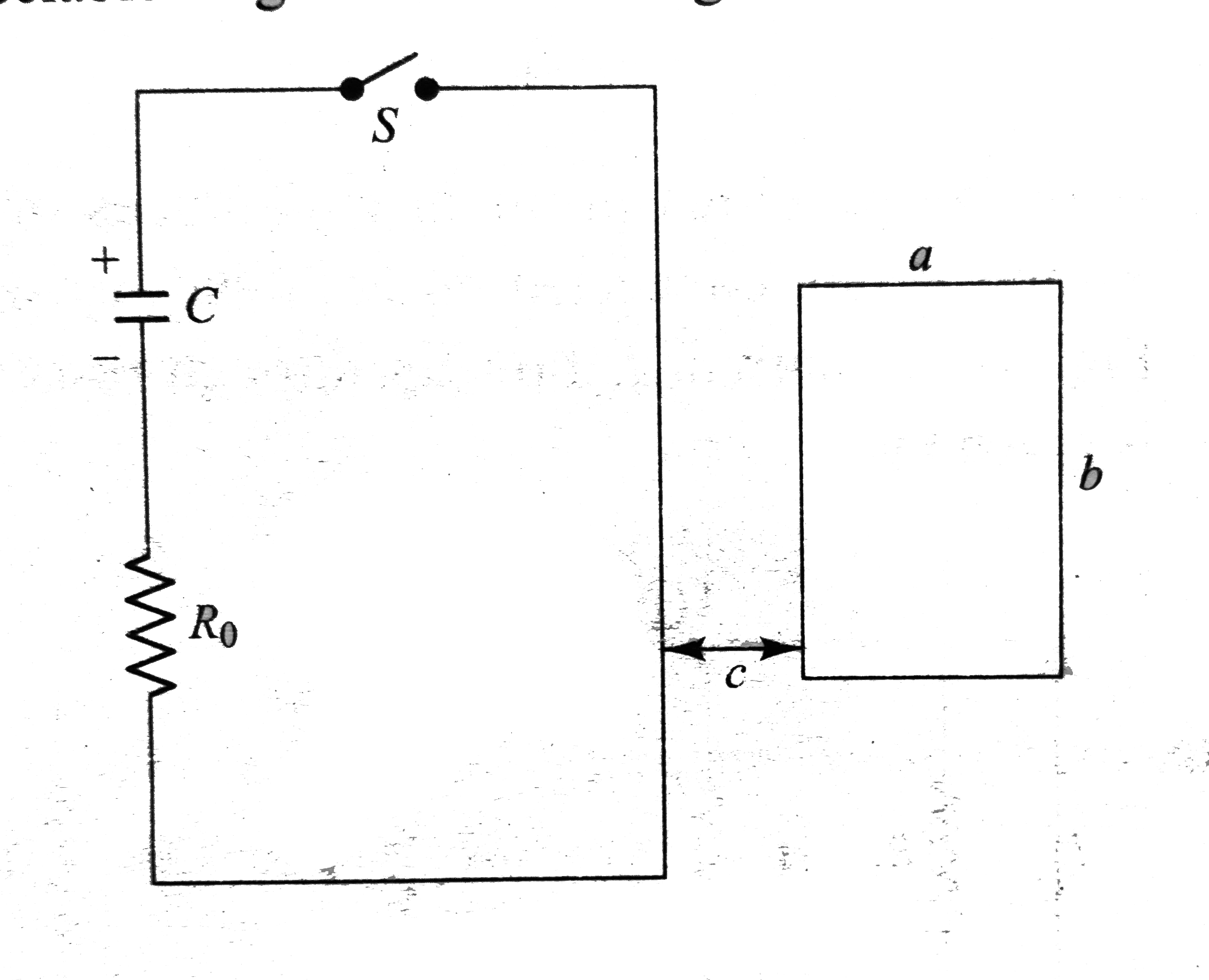
The current in the circuit 200ms after closing S is
View SolutionIn the circuit shown in Fig. the capacitor has capacitance C=20μF and is initially charged to 100V with the polarity shown. The resistor R0 has resistance 10Ω. At time t=0, the switch is closed. The smaller circuit is not connected in any way to teh larger one. the wire of the smaller circuit has a resistance of 1.0Ωm−1 and contains 25 loops. the larger circuit is a rectangle 2.0m by 4.0m, while the smaller one has dimensions a=10.0cm and b=20.0cm. the distance cis 5.0cm. (The figure is not drawn to scale.) Both circuit are held stationary. Assume that only the wire nearest to teh smaller circuit produces. an appreciable magnetic field through it.
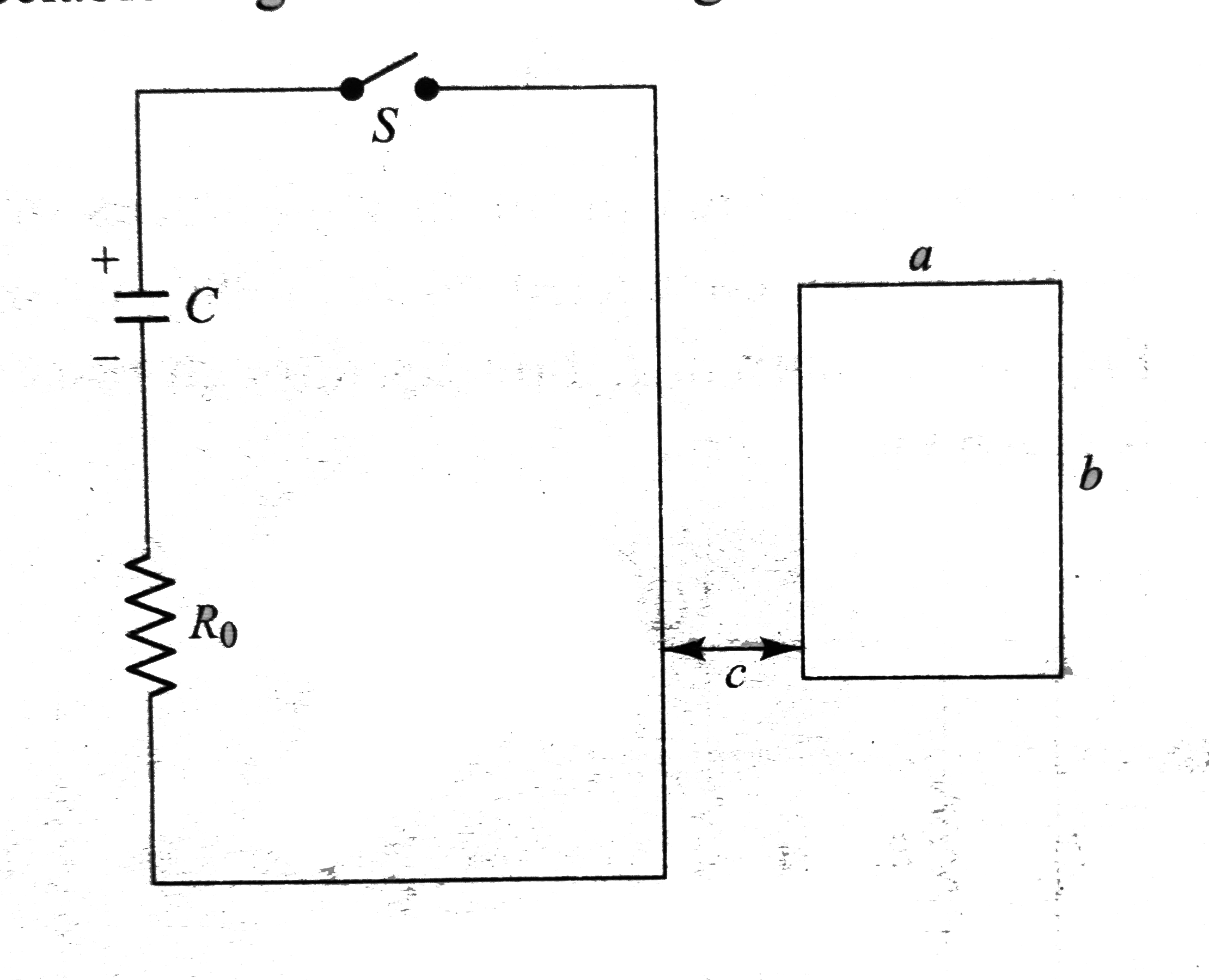
The curent in the smaller circuit 200μs after closing S is
View Solution
